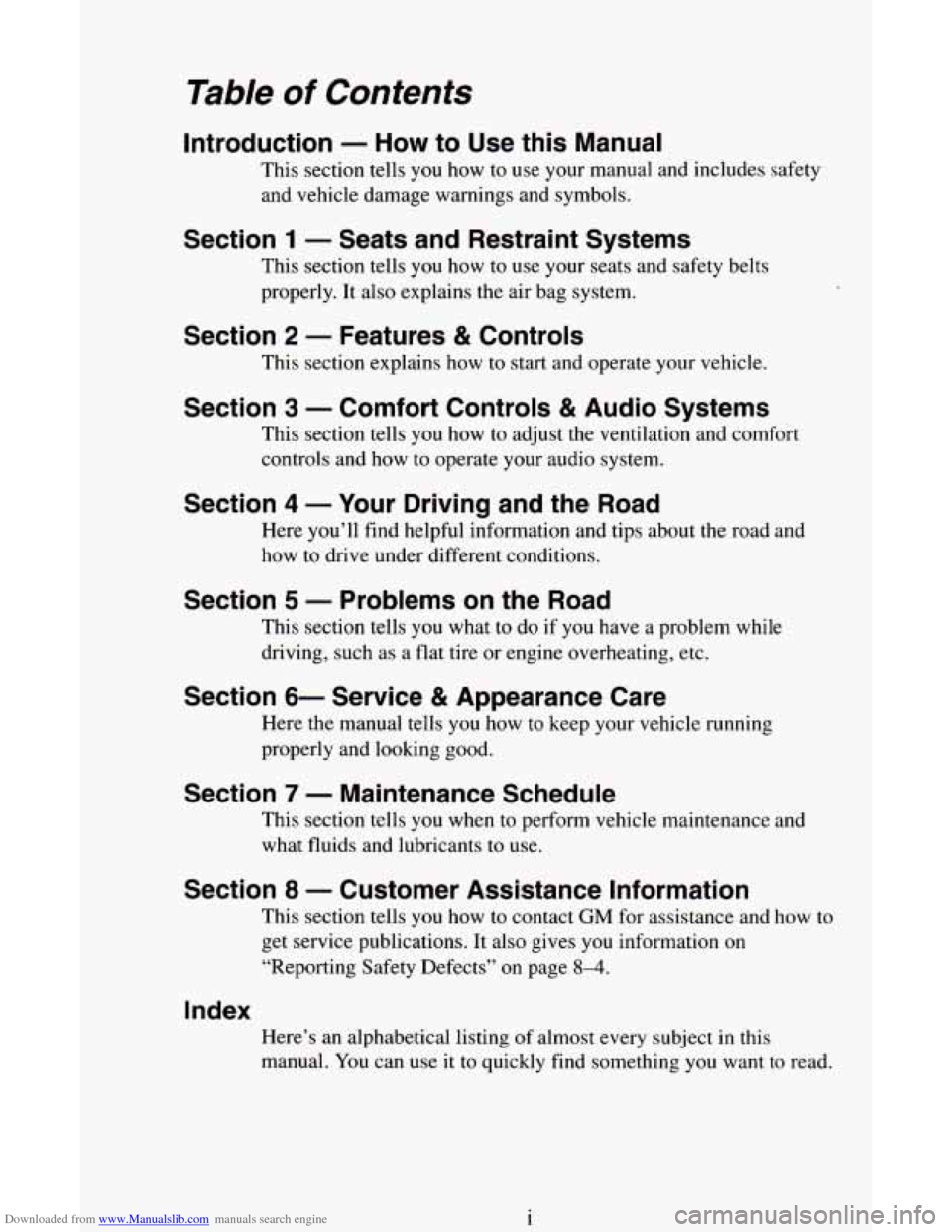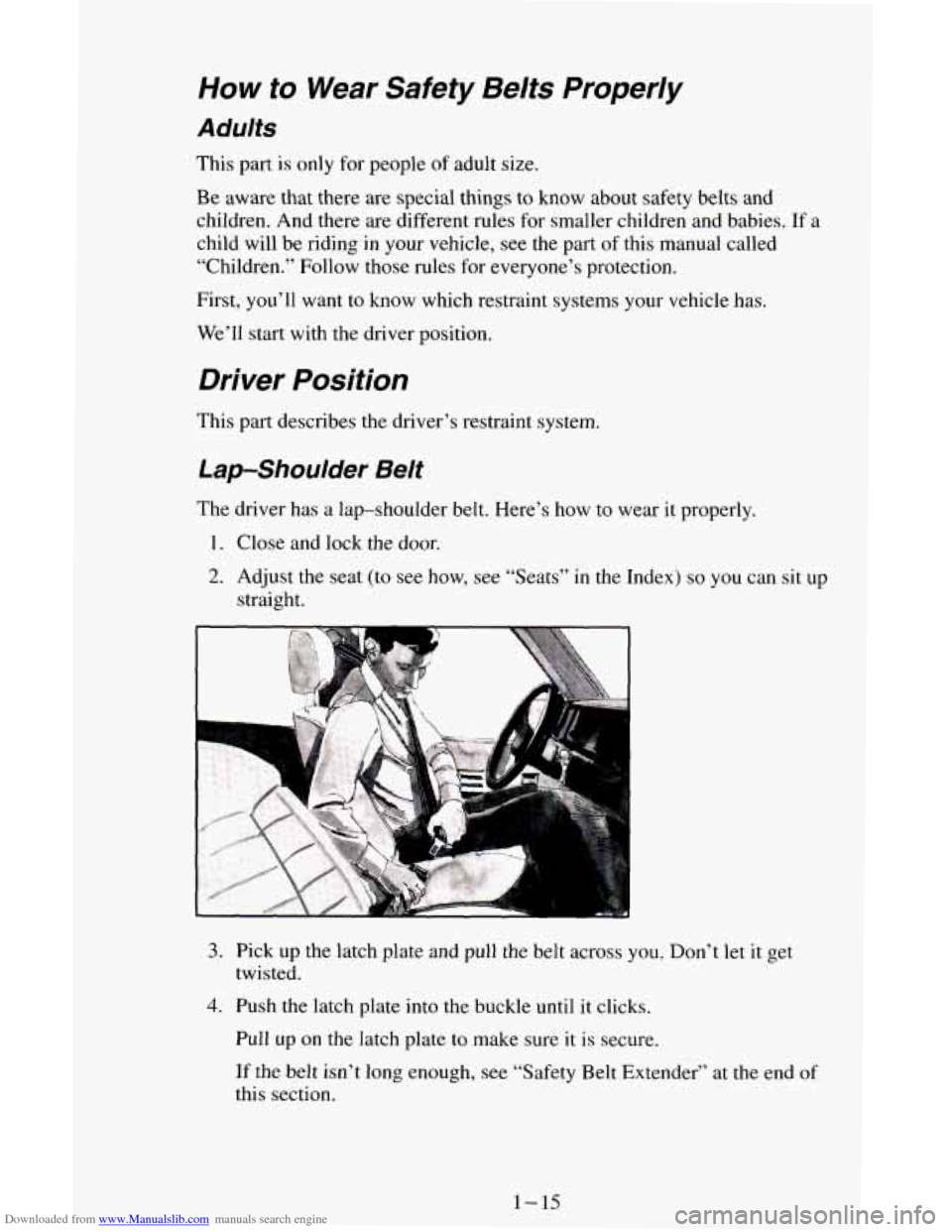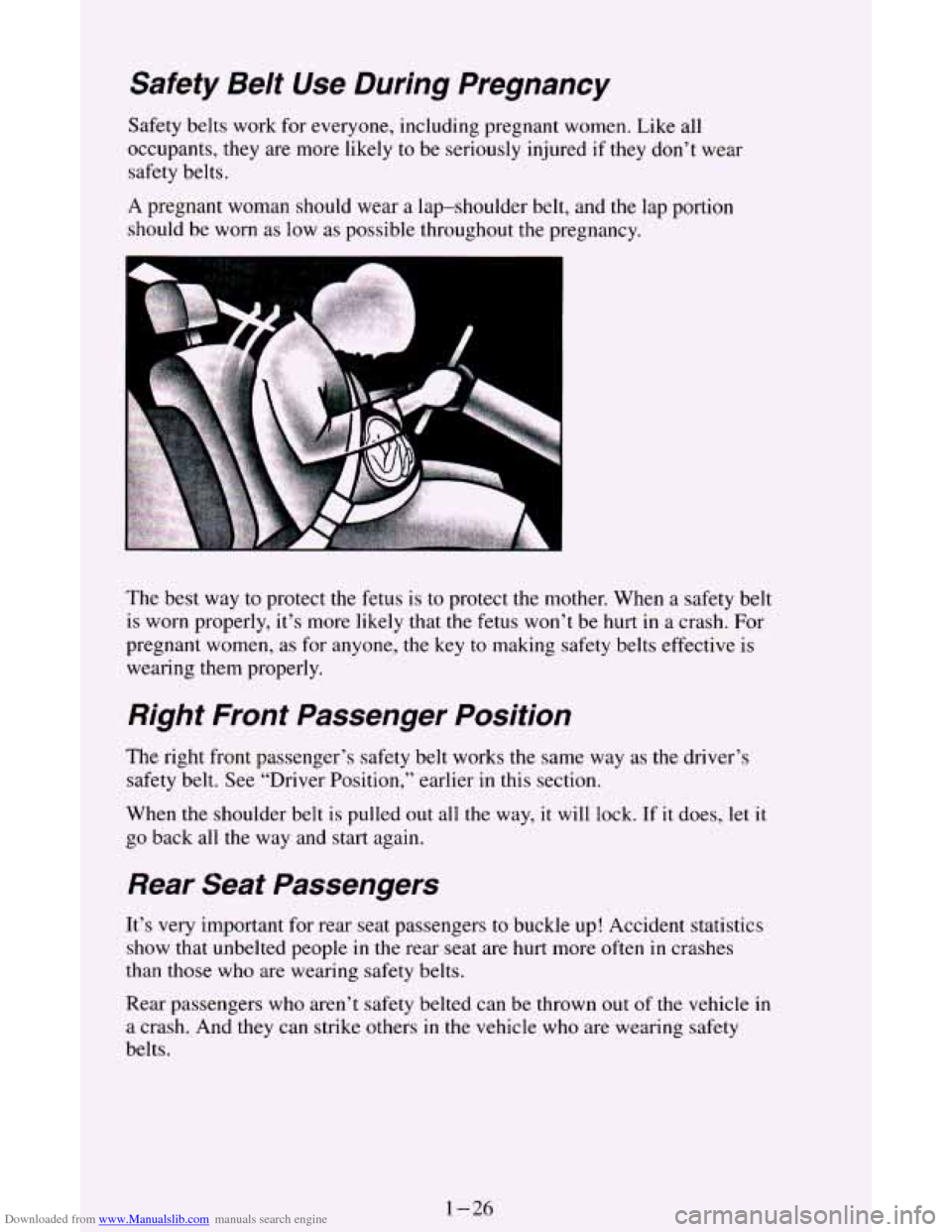Page 5 of 342

Downloaded from www.Manualslib.com manuals search engine Table of Contents
Introduction - How to Use this Manual
This section tells you how to use your manual and includes safety
and vehicle damage warnings and symbols.
Section 1 - Seats and Restraint Systems
This section tells you how to use your seats and safety belts
properly. It also explains the air bag system.
Section 2 - Features & Controls
This section explains how to start and operate your vehicle.
Section 3 - Comfort Controls & Audio Systems
This section tells you how to adjust the ventilation and comfort
controls and how
to operate your audio system.
Section 4 - Your Driving and the Road
Here you’ll find helpful information and tips about the road and
how
to drive under different conditions.
Section 5 - Problems on the Road
This section tells you what to do if you have a problem while
driving, such as a flat tire or engine overheating, etc.
Section 6- Service & Appearance Care
Here the manual tells you how to keep your vehicle running
properly and looking good.
Section 7 - Maintenance Schedule
This section. tells you when to perform vehicle maintenance and
what fluids and lubricants to use.
Section 8 - Customer Assistance Information
This section tells you how to contact GM for assistance and how to
get service publications. It also gives you information on
“Reporting Safety Defects” on page
8-4.
Index
Here’s an alphabetical listing of almost every subject in this
manual. You can use
it to quickly find something you want to read.
1
Page 13 of 342
Downloaded from www.Manualslib.com manuals search engine Seats and Restraint Systems
Section
Here you’ll find information about the seats in your vehicle and how to use
your safety belts properly.
You can also learn about some things you should
nut do with air bags and safety belts.
Seats and Seat Controls
This section tells you about the seats-how to adjust them, take them out
and put them back
in. It also tells you about bucket and bench seats, power
seats, and head restraints.
Front Seats
A CAUTION:
You can lose control of the vehicle if you try to adjust a manual
driver’s seat while the vehicle
is moving. The sudden movement
could startle and confuse you,
or make you push a pedal when
you don’t want to. Adjust the driver’s seat only when th\
e vehicle
is not moving.
1-1
Page 16 of 342
Downloaded from www.Manualslib.com manuals search engine The lap belt can’t do its job either. In a crash the belt could go
Rear Seats
Bucket Seats
If you have rear bucket seats in your vehicle, they will recline and adjust the
same way as the front manual bucket seats. See “Front Seats” earlier in this
section or in the Index.
Bench Seats
If you have bench seats in your vehicle, each seat can carry up to three
passengers. They can also be removed
to increase storage space.
The center and rear bench seats can be adjusted forward or rearward by the
lever
at the front of the seat.
1-4
Page 18 of 342
Downloaded from www.Manualslib.com manuals search engine To raise or lower the
center console, press
the button between the
beverage holders.
Only sit
in the center
seating position when
the console
is in an
upright position. For
details about
headrests, see “Head
Restraints’’ in this
section.
Seatback Latches (Non-Touring Bench Seats)
To fold your
non-touring seatback
forward,
pull up on
the latch release lever
while pulling the
seatback toward
you.
The lever is on the
right rear
of your seat.
After the latch has been released, push
the seatback down until it locks in
place.
To raise the seatback, unlock the seat by pushing forward on the lever.
Make sure the seatback
is locked when it is put back in the upright position.
1-6
Page 27 of 342

Downloaded from www.Manualslib.com manuals search engine How to Wear Safety Belts Properly
Adults
This part is only for people of adult size.
Be aware that there are special things to know about safety belts and
children. And there are different rules for smaller children and babies. If
a
child will be riding in your vehicle, see the part of this manual called
“Children.” Follow those rules for everyone’s protection.
First, you’ll want to
know which restraint systems your vehicle has.
We’ll start with the driver position.
Driver Position
This part describes the driver’s restraint system.
Lap-Shoulder Belt
The driver has a lap-shoulder belt. Here’s how to wear it properly.
1. Close and lock the door.
2. Adjust the seat (to see how, see “Seats” in the Index) so you can sit up
straight.
3. Pick up the latch plate and pull the belt across you. Don’t let it get
4. Push the latch plate into the buckle until it clicks.
twisted.
Pull up
on the latch plate to make sure it is secure.
If the belt
isn’t long enough, see “Safetv Belt Extender” at the end of
this section.
1-15
Page 38 of 342

Downloaded from www.Manualslib.com manuals search engine Safety Belt Use During Pregnancy
Safety belts work for everyone, including pregnant women. Like all
occupants, they are more likely to be seriously injured if they don’t wear
safety belts.
A pregnant woman should wear a lap-shoulder belt, and the lap portion
should be worn as low as possible throughout
the pregnancy.
A
The best way to protect the fetus is to protect the mother. When a safety belt
is worn properly, it’s more likely that the fetus won’t be hurt
in a crash. For
pregnant women,
as for anyone, the key to making safety belts effective is
wearing them properly.
Right Front Passenger Position
The right front passenger’s safety belt works the same way as the driver’s
safety belt. See “Driver Position,” earlier in
this section.
When the shoulder belt is pulled out all the way, it will lock. If
it does, let it
go back all
the way and start again.
Rear Seat Passengers
It’s very important for rear seat passengers to buckle up! Accident statistics
show that unbelted people in the rear seat are hurt more often in crashes
than those who are wearing safety belts.
Rear passengers who aren’t safety belted can be thrown out of the vehicle
in
a crash. And they can strike others in the vehicle who are wearing safety
belts.
1-26
Page 39 of 342
Downloaded from www.Manualslib.com manuals search engine Rear Seat Outside Passenger Positions
Lap-Shoulder Belt
These positions have lap-shoulder belts. Here’s how to wear one properly.
1. Pick up the latch plate and pull it across you. Don’t let it get twisted.
2. Push the latch plate into the buckle until it clicks. If the belt stops
before it reaches the buckle, tilt the latch plate and keep pulling until
you can buckle
it. Pull up on the latch plate to make sure it is secure.
If the belt is not long enough, see “Safety Belt Extender’’ at the end of
this section.
Make sure the release button on the buckle
is positioned so you would
be able to unbuckle the safety belt quickly
if you ever had to.
1-27
Page 42 of 342
Downloaded from www.Manualslib.com manuals search engine Lap Belt
If your vehicle has rear bench seats, someone can sit in the center positions.
When you sit in
a center seating position, you have a lap safety belt, which
has
no retractor. To make the belt longer, tilt the latch plate and pull it along
the belt.
To make the belt shorter, pull its free end as shown until the belt is snug.
Buckle, position and release it the same way as the lap part
of a
lap-shoulder belt.
If the belt isn’t long enough, see “Safety Belt Extender”
at the end of this section.
Make sure the release button on
the buckle is positioned so you would be
able to unbuckle the safety belt quickly
if you ever had to.
1-30